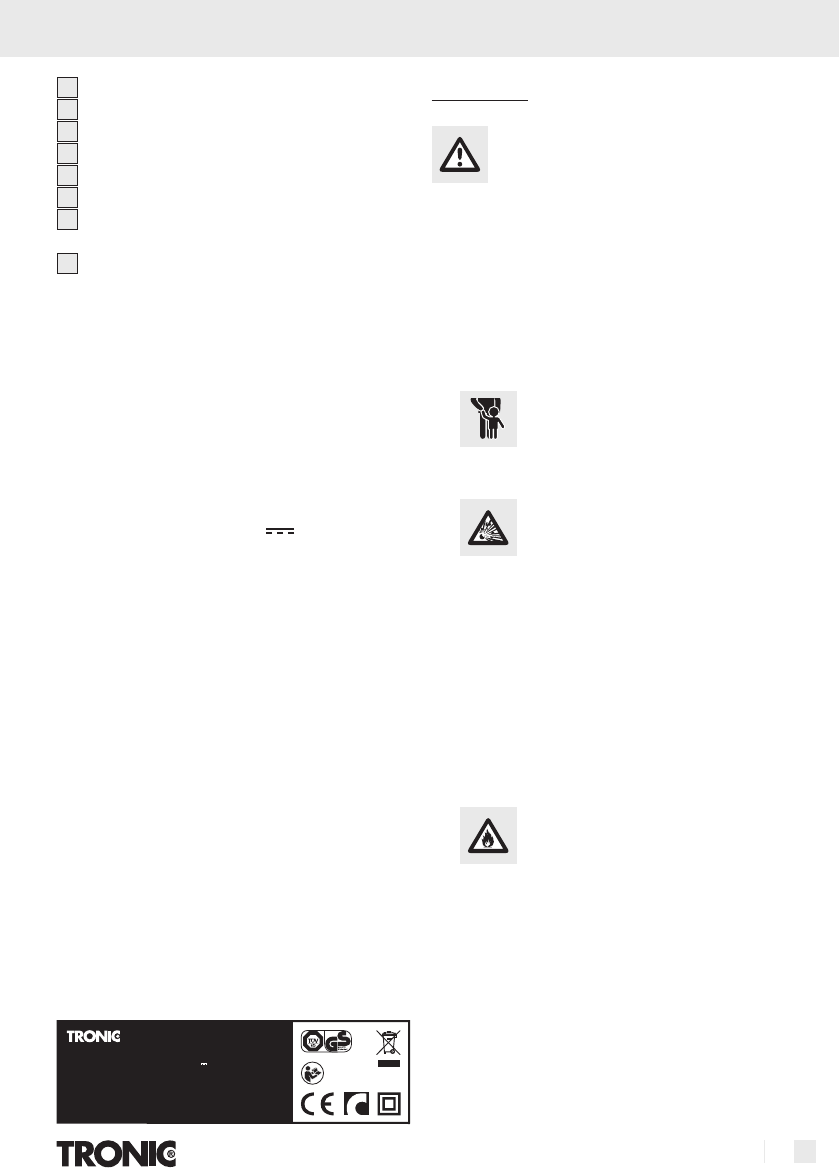
7 GB/IE/CY
Introduction / Safety
8
Q
Selection button „MODE“
9
Charging station
10
Mains cable with power plug
11
Fixing holes
12
„+“-Pole connection cable (red), incl. ring shoe
13
„–“-Pole connection cable (black), incl. ring shoe
14
„+“-Pole quick-contact terminal (red), incl. red
fixing screw
15
„–“-Pole quick-contact terminal (black), incl.
black fixing screw
Q
Technical Data
Input voltage: 220 - 240 V
~
50 / 60 Hz
Starting current: < 25 A
Input current: max. 0.6 A (Effective value)
Power
consumption: 55 W
Return current*: < 5 mA (no AC input)
Nominal voltage: 12 V DC
Nominal current: 0,8 / 3,6 A
Charging voltage: 14.4 V ± 0.25 V or
14.7 V ± 0.25 V
Charging current: max. 3.6 A (3.6 A ± 10 % or
0.8 A ± 10 %)
Noise value**: max. 150 mV
Battery type: 12 V lead acid battery
1.2 Ah - 120 Ah
Type of housing
protection: IP 65 (dustproof, waterproof)
Dimensions: 180 x 62 x 40 mm
(L x W x H)
Weight: 0.5 kg approx.
Noise level: < 50 dB (A) (tested from a
distance of 50 cm)
* = Return current is the current used by the
charging station battery, when no mains cur-
rent is connected.
** = Noise value is the disturbance of current and
voltage.
T4X KH 3157
220 V-240 V AC ~ 50 Hz / 60 Hz · 55 W
12 V DC
0,8 / 3,6 A · IP65
Polarity: red clamp (+), black clamp (-)
Date of manufacture: 02/2008
WARNING! Explosive gases
-
prevent
flames and sparks. Before charging,
study instruction sheet. Disconnect
supply before making or breaking
battery connections. Provide for good
ventilation.
Kompernaß GmbH · D- 44867 Bochum · Germany · www.kompernass.com
Q
Safety
Safety information
m Danger! Avoid danger to life and limbs
caused by improper use!
J Do not operate the appliance with a damaged
cable, power cord or plug.
m CAUTION! A damaged power cord causes
danger to life by electric shock.
J If damaged, have the power cord j repaired by
authorised and trained technicians only! Please
contact the service department for your country!
J
Do not allow toddlers or children
near the charging station without
super-vision! Children cannot assess
the potential danger in the handling of electrical
equipment.
J
Explosion hazard! Protect your-
self from a highly explosive oxyhydro-
gen gas reaction! Gaseous hydrogen
can leak from the battery during the charging
and discharging process. Oxyhydrogen gas is
an explosive mixture of gaseous hydrogen and
oxygen. The result is the so-called oxyhydrogen
reaction upon contact with open fire (flames,
embers or sparks)! Carry out the charging or
discharging procedure in a wellventilated room
protected from the weather. Make sure that there
are no sources of open fire (flames, embers or
sparks) in the vicinity when charging or discharg-
ing batteries!
J
Danger of explosion and fire!
Make sure that explosive and flam-
mable substances e.g. petrol or sol-
vents can be ignited when using the charging
station!
m Danger of chemical burns! Protect your
eyes and skin against chemical burns caused
by acid (sulphuric acid) upon contact with the
battery! Do not look directly at the connected
battery and use the following: acid-resistant
safety glasses, protective clothing and gloves!
If your eyes or skin come into contact with sul-
phuric acid, rinse the affected part of the body
with plenty of clear running water and seek
immediate medical assistance!












